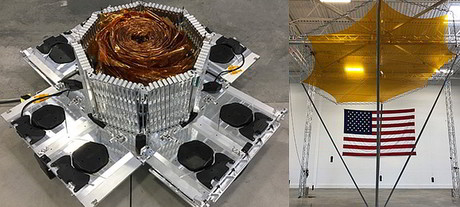High-performance antenna in a small package

The R3D2 satellite aims to space-qualify a new membrane reflectarray antenna, which stows tightly for launch and deploys to full size in orbit.
The US Defense Advanced Research Projects Agency’s (DARPA) Radio Frequency Risk Reduction Deployment Demonstration (R3D2) satellite is set for launch in late February, aiming to space-qualify a new type of membrane reflectarray antenna. The antenna, made of a tissue-thin Kapton membrane, packs tightly for stowage during launch and then was to deploy to its full size of 2.25 m in diameter once it reached low Earth orbit.
R3D2 will monitor antenna deployment dynamics, survivability and RF characteristics of a membrane antenna in low Earth orbit. The antenna could enable multiple missions that currently require large satellites, including providing high-data-rate communications to users on the ground.
A successful mission also will help demonstrate a smaller, faster-to-launch and lower-cost capability, enabling the US Department of Defense, as well as other users, to make the most of the new commercial market for small, inexpensive launch vehicles.
The design, development and launch of the 150 kg satellite took approximately 18 months. Northrop Grumman was the prime contractor and integrator, MMA Design designed and built the antenna, Trident Systems designed and built R3D2’s software-defined radio, and Blue Canyon Tech provided the spacecraft bus.


“The Department of Defense has prioritised rapid acquisition of small satellite and launch capabilities. By relying on commercial acquisition practices, DARPA streamlined the R3D2 mission from conception through launch services acquisition,” said Fred Kennedy, Director of DARPA’s Tactical Technology Office.
“This mission could help validate emerging concepts for a resilient sensor and data transport layer in low Earth orbit — a capability that does not exist today, but one which could revolutionise global communications by laying the groundwork for a space-based internet.”
The launch will take place on a Rocket Lab USA Electron rocket from Rocket Lab’s launch complex on the Mahia Peninsula of New Zealand.
To ensure precise insertion and responsible orbital deployment, the R3D2 payload will be deployed via the Electron Kick Stage to a circular orbit. Using this unique launch method, Electron’s second stage is left in a highly elliptical orbit where the stage is subject to significant atmospheric drag, causing it to de-orbit and burn up to nothing in a reduced time frame. The Kick Stage is then used to deploy the satellite payload to a precise orbit, following which the Kick Stage can perform a de-orbit burn to speed up its re-entry, leaving no orbital debris behind in space.

Rocket Lab says its Electron launch experience is the world’s first customised small satellite launch service. With the choice of two Rocket Lab launch sites, and the ability to rapidly launch to orbit as frequently as every 72 hours, each mission is tailored to the customer requirements.
“Rapid acquisition of small satellite launch capabilities is increasingly important to US Government organisations like DARPA. The ability to rapidly space-qualify new technology and deploy space-based assets with confidence on short notice is a service that didn’t exist for dedicated small satellites until now,” said Rocket Lab founder and CEO Peter Beck.
“We’re honoured to provide Electron’s agile and flexible launch service to DARPA and we look forward to delivering the innovative R3D2 payload to orbit.”
Please follow us and share on Twitter and Facebook. You can also subscribe for FREE to our weekly newsletter and bimonthly magazine.
2025–26 Thought Leaders: Tim Karamitos
Tim Karamitos from Ericsson discusses the connectivity requirements of emergency services and...
2025–26 Thought Leaders: Ruth Tovo
Comms Connect panellist Ruth Tovo, from the South Australian SES, discusses the technical...
ARCIA update: celebrating excellence in our industry
The ARCIA Annual Gala Dinner and Excellence Awards took place during the same week as Comms...



